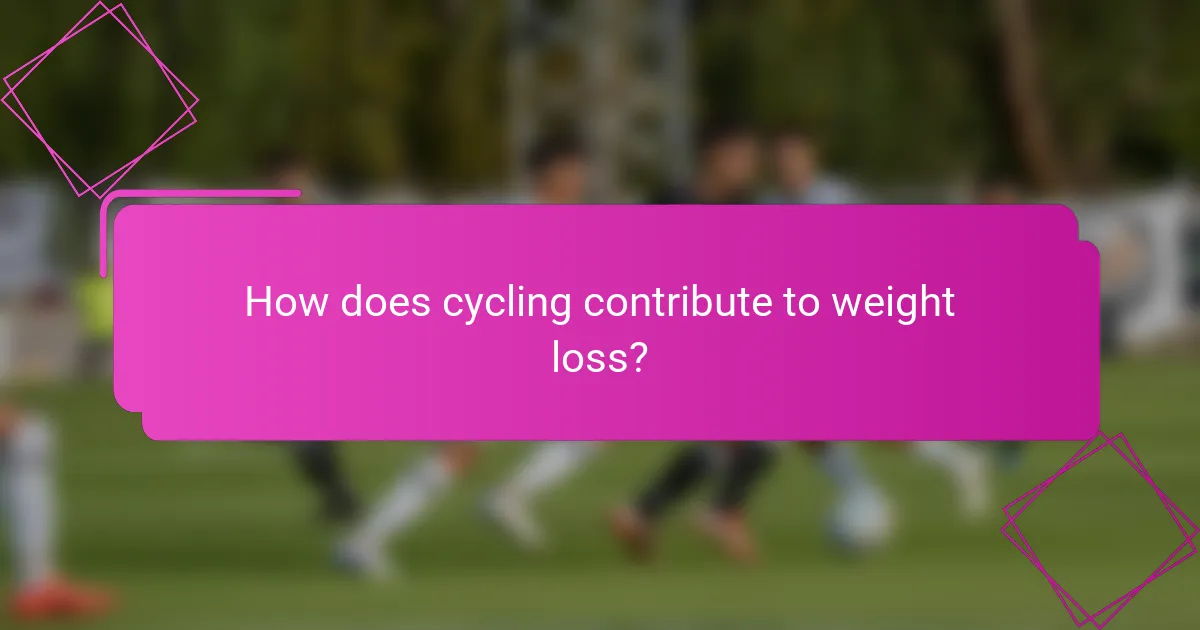Cycling is an effective exercise for weight loss, burning significant calories while improving cardiovascular health. This article explores strategies for maximising weight loss through cycling, including dietary tips for optimal nutrition, and methods for tracking progress with metrics like distance and calories burned. Understanding psychological factors can enhance motivation and commitment, while avoiding common mistakes ensures sustainable results.

How does cycling contribute to weight loss?
Cycling significantly contributes to weight loss by burning calories and increasing metabolism. Engaging in cycling for at least 30 minutes can burn around 300-600 calories, depending on intensity and body weight. This aerobic exercise enhances cardiovascular health and builds muscle, which further aids in fat loss. Additionally, combining cycling with a balanced diet rich in lean proteins and whole grains optimises results. Tracking progress through metrics like distance, time, and calories burned can help maintain motivation and ensure consistent weight loss.
What are the key physiological benefits of cycling for weight management?
Cycling significantly aids weight management by enhancing calorie burn, improving metabolism, and building muscle. Regular cycling can burn approximately 400-1000 calories per hour, depending on intensity and rider weight. This activity boosts cardiovascular health, leading to better oxygen delivery and fat utilisation. Additionally, cycling increases muscle mass, which elevates resting metabolic rate, promoting further weight loss. As a result, individuals can achieve sustainable weight management through consistent cycling routines combined with a balanced diet.
How does cycling intensity affect calorie burn?
Higher cycling intensity increases calorie burn significantly. Intense cycling can burn 600-1000 calories per hour, compared to moderate cycling at 300-600 calories. Factors like duration, body weight, and cycling efficiency also influence total calorie expenditure. Adjusting intensity levels can optimise weight loss efforts effectively.
Which cycling styles are most effective for losing weight?
High-intensity interval training (HIIT) cycling and endurance cycling are the most effective styles for losing weight. HIIT cycling burns calories rapidly by alternating between intense bursts and recovery periods. Endurance cycling, on the other hand, promotes fat burning through sustained, moderate-intensity efforts. Both styles can be tailored to individual fitness levels and preferences, enhancing weight loss outcomes.

What dietary strategies complement cycling for weight loss?
Cycling for weight loss is best complemented by a balanced diet rich in whole foods. Focus on high-protein meals, healthy fats, and complex carbohydrates to fuel your rides and aid recovery.
1. Prioritise lean proteins like chicken, fish, and legumes to support muscle repair.
2. Incorporate healthy fats from sources such as avocados, nuts, and olive oil for energy.
3. Choose complex carbohydrates like whole grains and vegetables for sustained energy during rides.
4. Stay hydrated with water and electrolyte-rich drinks to maintain performance and recovery.
5. Monitor portion sizes to create a calorie deficit while ensuring nutritional adequacy.
6. Track progress with a food diary or app to adjust dietary strategies as needed.
How can meal timing enhance cycling performance and fat loss?
Meal timing can significantly enhance cycling performance and fat loss by optimising energy levels and metabolic responses. Consuming carbohydrates before rides fuels endurance, while post-ride protein intake aids recovery and muscle repair.
Strategically timing meals around workouts can maximise fat oxidation. For example, exercising in a fasted state may increase fat utilisation, but consuming a balanced meal shortly after training replenishes glycogen stores effectively.
Research shows that cyclists who eat within 30 minutes post-exercise experience improved recovery and better performance in subsequent workouts. This approach not only supports weight loss but also enhances overall cycling efficiency.
Incorporating nutrient timing into a cycling regimen can lead to sustainable weight loss and improved performance metrics.
Which foods should be prioritised for cyclists aiming to lose weight?
Cyclists aiming to lose weight should prioritise whole foods rich in nutrients and low in calories. Focus on lean proteins, vegetables, whole grains, and healthy fats to support energy needs while promoting weight loss.
1. Lean proteins: Chicken breast, turkey, and fish provide essential amino acids for muscle recovery.
2. Vegetables: Leafy greens, broccoli, and peppers are low in calories and high in fibre.
3. Whole grains: Quinoa, brown rice, and oats offer sustained energy and promote satiety.
4. Healthy fats: Avocados, nuts, and olive oil support overall health and can aid in weight management.
5. Hydration: Water and herbal teas help maintain performance and curb hunger.
What role do hydration and electrolyte balance play in weight loss while cycling?
Hydration and electrolyte balance are crucial for effective weight loss while cycling. Proper hydration enhances performance and prevents fatigue, allowing for longer rides and higher calorie burn. Electrolytes, such as sodium and potassium, help maintain fluid balance and muscle function, which are vital during intense cycling sessions. Dehydration can lead to decreased endurance and increased risk of injury, hindering weight loss efforts. Aim to drink water consistently and consider electrolyte-rich drinks during long rides to optimise your cycling performance and weight loss goals.

How can progress be effectively tracked during a cycling weight loss journey?
To effectively track progress during a cycling weight loss journey, utilise a combination of metrics and tools. Focus on monitoring distance cycled, duration of rides, and calories burned. Use a fitness app or wearable device to log these metrics consistently. Regularly assess body measurements and weight to gauge overall progress. Setting specific, measurable goals enhances motivation and accountability.
What metrics should cyclists monitor to gauge weight loss success?
Cyclists should monitor metrics such as weight, body measurements, cycling distance, calorie expenditure, and workout intensity to gauge weight loss success. Tracking these factors provides insights into progress and helps adjust training and diet strategies effectively.
| Metric | Description |
|————————-|————————————–|
| Weight | Overall body weight changes |
| Body Measurements | Changes in waist, hips, and arms |
| Cycling Distance | Total miles cycled per week |
| Calorie Expenditure | Calories burned during cycling |
| Workout Intensity | Average heart rate or perceived effort |
How can technology assist in tracking cycling performance and weight loss?
Technology assists in tracking cycling performance and weight loss by providing real-time data and analytics. Wearable devices like fitness trackers monitor heart rate, distance, and calories burned. Cycling apps offer route mapping and performance metrics, helping cyclists set goals and track progress. Smart bikes and sensors provide detailed insights into speed and cadence, enhancing training effectiveness. Integration with diet tracking apps allows for comprehensive weight loss management by correlating exercise with caloric intake.
What are the best practices for setting realistic weight loss goals through cycling?
To set realistic weight loss goals through cycling, focus on gradual progress and measurable outcomes. Start by determining a safe weight loss rate, typically 1-2 pounds per week. Incorporate regular cycling sessions, aiming for at least 150 minutes of moderate-intensity activity weekly. Track your cycling distance, duration, and calories burned to maintain motivation. Adjust your diet to support your goals, emphasising whole foods and balanced nutrition. Celebrate small milestones to sustain long-term commitment.

Which psychological factors influence cycling habits for weight loss?
Psychological factors significantly influence cycling habits for weight loss. Motivation, self-efficacy, and goal-setting are key drivers.
Motivation can stem from intrinsic desires, such as enjoyment, or extrinsic factors like social support. Self-efficacy, or belief in one’s ability to succeed, impacts consistency in cycling. Setting realistic and measurable goals enhances commitment and progress tracking.
Additionally, positive reinforcement and visualization techniques can further reinforce cycling habits. Understanding these psychological aspects can lead to more effective cycling strategies for weight loss.
How can motivation be maintained throughout a cycling weight loss program?
To maintain motivation throughout a cycling weight loss program, set specific goals and track your progress. Establish a routine that includes enjoyable cycling routes and varying intensities. Incorporate social support by joining cycling groups or participating in challenges. Celebrate small milestones to reinforce positive behaviour and stay engaged.
What community resources are available to support cyclists in their weight loss journey?
Cyclists can access various community resources to aid their weight loss journey, including local cycling clubs, fitness groups, and online forums. These platforms provide support, motivation, and shared experiences.
Local cycling clubs often organise group rides, offering social interaction and accountability. Fitness groups may focus on overall health, incorporating cycling into broader weight loss strategies. Online forums and social media groups allow cyclists to share tips, progress, and encouragement, creating a supportive community.
Additionally, community events, such as charity rides and cycling workshops, promote engagement and education on effective weight loss strategies through cycling. These resources foster a sense of belonging while helping cyclists stay committed to their weight loss goals.

What common mistakes should be avoided when cycling for weight loss?
To achieve weight loss through cycling, avoid these common mistakes. Focusing solely on cycling without incorporating strength training can hinder muscle development. Neglecting proper nutrition leads to insufficient calorie deficits. Overtraining without adequate rest can cause burnout and injuries. Ignoring hydration affects performance and recovery. Setting unrealistic goals may result in frustration and discouragement. Lastly, not tracking progress can prevent adjustments needed for continued success.
How can overtraining impact weight loss efforts in cycling?
Overtraining can hinder weight loss efforts in cycling by causing fatigue, decreased performance, and hormonal imbalances. This leads to increased stress levels, which can trigger weight gain instead of loss. Cyclists should monitor training intensity and recovery to avoid these negative impacts. Regular rest days and balanced nutrition support sustainable weight loss.
What are the pitfalls of relying solely on cycling for weight loss?
Relying solely on cycling for weight loss can lead to several pitfalls. First, it may create muscle imbalances since cycling primarily targets the lower body, neglecting upper body strength. Second, overdependence on one activity can lead to boredom, reducing motivation and adherence. Third, cycling alone may not generate a significant calorie deficit if dietary habits are not aligned with weight loss goals. Lastly, it can increase the risk of overuse injuries if not balanced with cross-training or rest days.
How can cyclists ensure they are not sacrificing muscle mass during weight loss?
Cyclists can maintain muscle mass during weight loss by focusing on a balanced diet, strength training, and proper recovery. Consuming adequate protein is essential; aim for 1.2 to 2.0 grams per kilogram of body weight. Incorporate resistance exercises to stimulate muscle growth while cycling. Monitor caloric intake to ensure a moderate deficit, avoiding excessive cuts that can lead to muscle loss. Prioritise rest days to allow muscle repair and growth, supporting overall performance and weight loss goals.

What expert tips can enhance cycling effectiveness for weight loss?
To enhance cycling effectiveness for weight loss, focus on structured workouts, proper nutrition, and consistent tracking. Incorporate interval training to maximise calorie burn. Aim for a balanced diet rich in whole foods, and monitor progress with a cycling app for motivation and adjustments.
How can cross-training benefit cycling for weight loss?
Cross-training can enhance cycling for weight loss by improving overall fitness and preventing burnout. It incorporates different exercises, which can increase calorie burn and muscle engagement. For example, strength training can boost metabolism by building lean muscle mass, while activities like swimming or running can improve cardiovascular endurance. This varied approach helps maintain motivation and reduces the risk of injury, making weight loss more sustainable.
What role does rest and recovery play in a cycling weight loss plan?
Rest and recovery are crucial in a cycling weight loss plan as they enhance performance and prevent injuries. Adequate rest allows the body to repair muscle tissues damaged during rides, facilitating weight loss through improved metabolism. Recovery periods also reduce fatigue and stress, which can hinder weight loss efforts. Incorporating rest days into training schedules can optimise calorie burn and support sustainable weight loss.
How can cyclists create a sustainable long-term weight management strategy?
Cyclists can create a sustainable long-term weight management strategy by combining regular cycling with a balanced diet and consistent progress tracking. Focus on incorporating varied cycling intensities to boost metabolism and maintain muscle mass.
1. Set realistic weight loss goals based on cycling frequency and duration.
2. Monitor dietary intake, prioritising whole foods and proper hydration.
3. Use cycling apps or journals for tracking progress and adjusting strategies.
4. Incorporate strength training to enhance overall fitness and support weight management.
By focusing on these elements, cyclists can achieve lasting weight management while enjoying their sport.